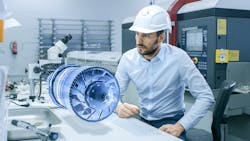Augmented Reality Is Ready for Its Close Up on the Training Floor
Not everyone learns the same way, and different types of learning—auditory, visual, tactile, kinesthetic or a mix—aren’t always well-represented in academia or company training programs.
According to a 2018 IndustryWeek/Poka survey of 426 manufacturing leaders, the most effective training method is on-the-floor pairing/shadowing where trainees observe and interact with experts performing the actual job. But this kinesthetic one-off pairing approach can be expensive, taking experienced workers off the production floor to train. Also, paper-based work instructions may make training outdated or ineffective.
Augmented reality can help resolve these challenges. Here are four ways AR delivers information throughout the learning and development lifecycle, and the advantages of each:
1. Visualization & demonstration for training: Interactive guided instructions, procedures, and digital content are delivered in 3D within a simulated context.
• Lowers material and prototype overhead costs through digitally delivered content
• By delivering only relevant content on demand, it reduces cost of worker downtime and ramp-up time.
• Captures expert workflows to educate and quickly on-board junior-level staff with augmented instructions using AR headsets or a mobile device.
While learning management systems have made relevant information digitized, training through AR provides a 3D format and kinesthetic-friendly approach, which capitilizes on a mix of learning methods that improve knowledge retention. AR is also more cost-effective than planning downtime for training on real-world equipment or using physical materials for training prototypes.
Case Study: GSI (an AGCO brand), a manufacturer of grain storage systems, found it unfeasible to bring its massive equipment to its weeklong training class for new hires and, instead, presented hundreds of slides. It combined this with paper manuals to deliver information to its field workers, including new features and models. By moving to augmented reality for immersive training of its field workers, GSI reduced installation time of new grain system designs by 60%.
2. On-the-job work instructions: Overlaid in-context digital information including step-by-step sequences and work instructions.
• Increases productivity by delivering accurate necessary guidance
• Improves retention with 3D content in context
• Reduces paper bottlenecks to improve scalability and lower cost
• Improves manufacturing processes, including assembly, machine setup and changeover, and maintenance, by getting accurate and up-to-date hard metrics and other work information to the right worker.
These updateable and scalable digital capabilities are increasingly valuable to be flexible and agile and manage the information overload from rapidly changing markets and product/service complexity.
Case Study: Volvo Group is accommodating for custom configurations and customer requirements while maintaining the highest quality of its engines by equipping its quality assurance (QA) operators with on-the-job work instructions through AR. Each engine requires 40 QA checks, with 200 possible information variants, to be completed in eight minutes. AR gives Volvo flexibility to manage this complex process and its workers agility by providing operators the accurate ‘just-in-time’ quality checklist in context.
3. Remote assistance: Instantly connects remote experts to field personnel through a live video feed for over-the-shoulder support where both the expert and end user can collaborate in real time and quickly solve complex or unexpected problems.
• Reduces travel costs for experts
• Increases scalability and accessibility of expertise
• Reduces cost of worker downtime
• Helps quickly solve complex or unexpected problems
4. Expert Capture and Knowledge Transfer: Content creation by capturing expert workflows enables rapid documentation (such as standard operating procedures) to new or existing workers for hands-on training or task guidance.
· Increases scalability and accessibility of expertise
· Can improve training on-ramp times and knowledge retention
· Helps ensure safety and compliance in regulated environments
Remote assistance and knowledge transfer both present an effective way to capture and scale worker expertise residing in industrial companies.
Case Study: GlobalFoundries was plagued with production bottlenecks due to a lack of detailed standard operating procedures across its facilities. This inhibited worker productivity and drove up training costs. The semiconductor manufacturer implemented augmented reality as the standardized and scalable platform to deliver work instructions. This implementation reduced scrap and rework by 25%, accelerated training on-ramp time by 40%, reduced documentation authoring time by 50%, and decreased unscheduled downtime by 25%.
Augmented Reality for the Learning Lifecycle
People are pivotal assets on companies’ financial statements, yet empowering them through technology hasn’t proliferated for many organizations. With organizations facing substantial macroeconomic issues like rapidly changing markets, the aging workforce and looming skills gap, they must consider how to best teach and enable their employees. In an increasingly complex world, learning and skills development is more an ongoing progression and less a checkmark on an HR competency sheet.
About the Author
David Immerman
David Immerman is a Senior Research Analyst at PTC providing thought leadership on technologies, trends, markets, and other topics. Previously David was an industry analyst in 451 Research’s Internet of Things channel primarily covering the smart transportation space and automotive technology markets, including fleet telematics, connected cars, and autonomous vehicles. He also spent time researching IoT-enabling technologies and other industry verticals including industrial. Prior to 451 Research, David conducted market research at IDC.
